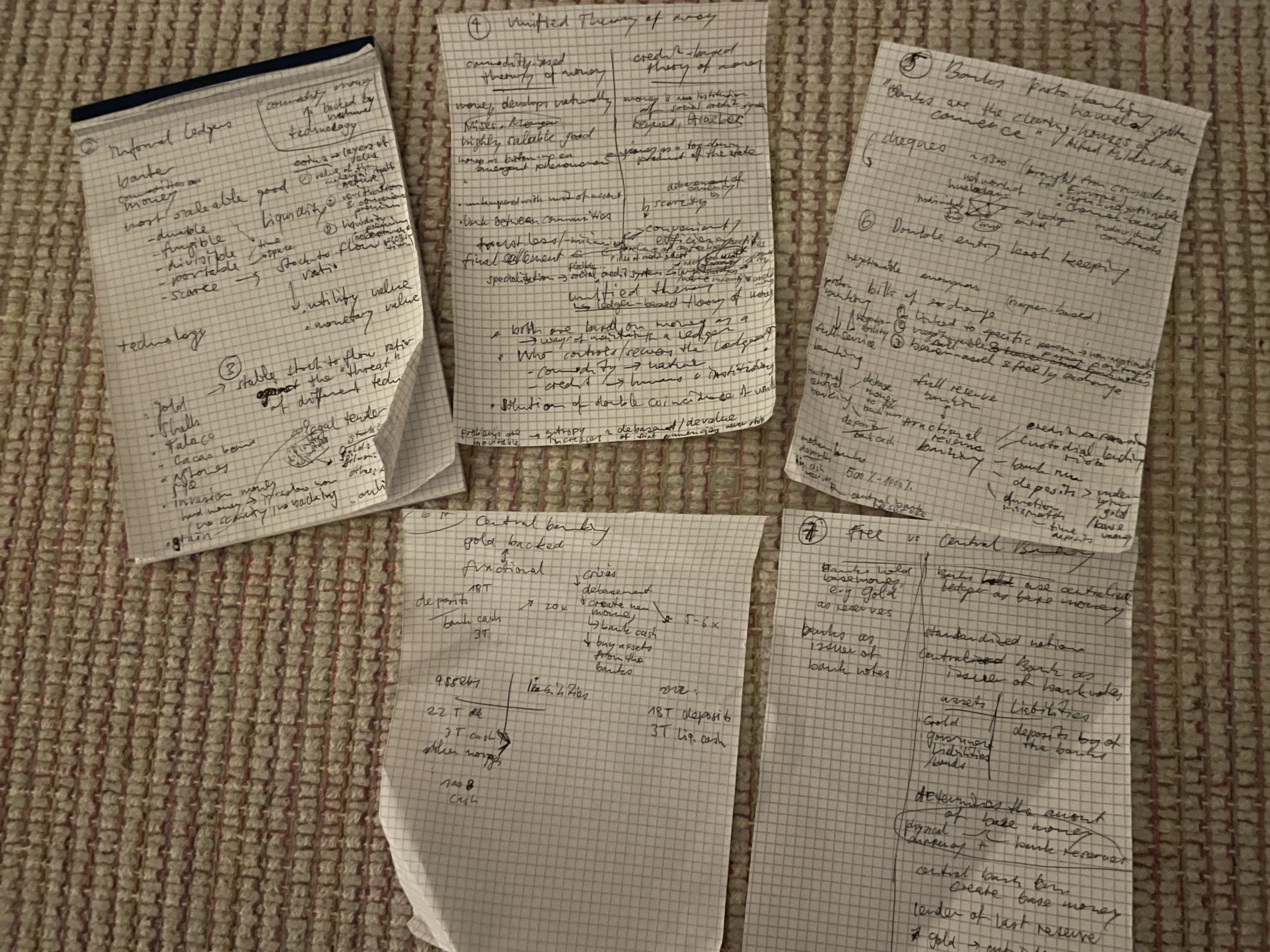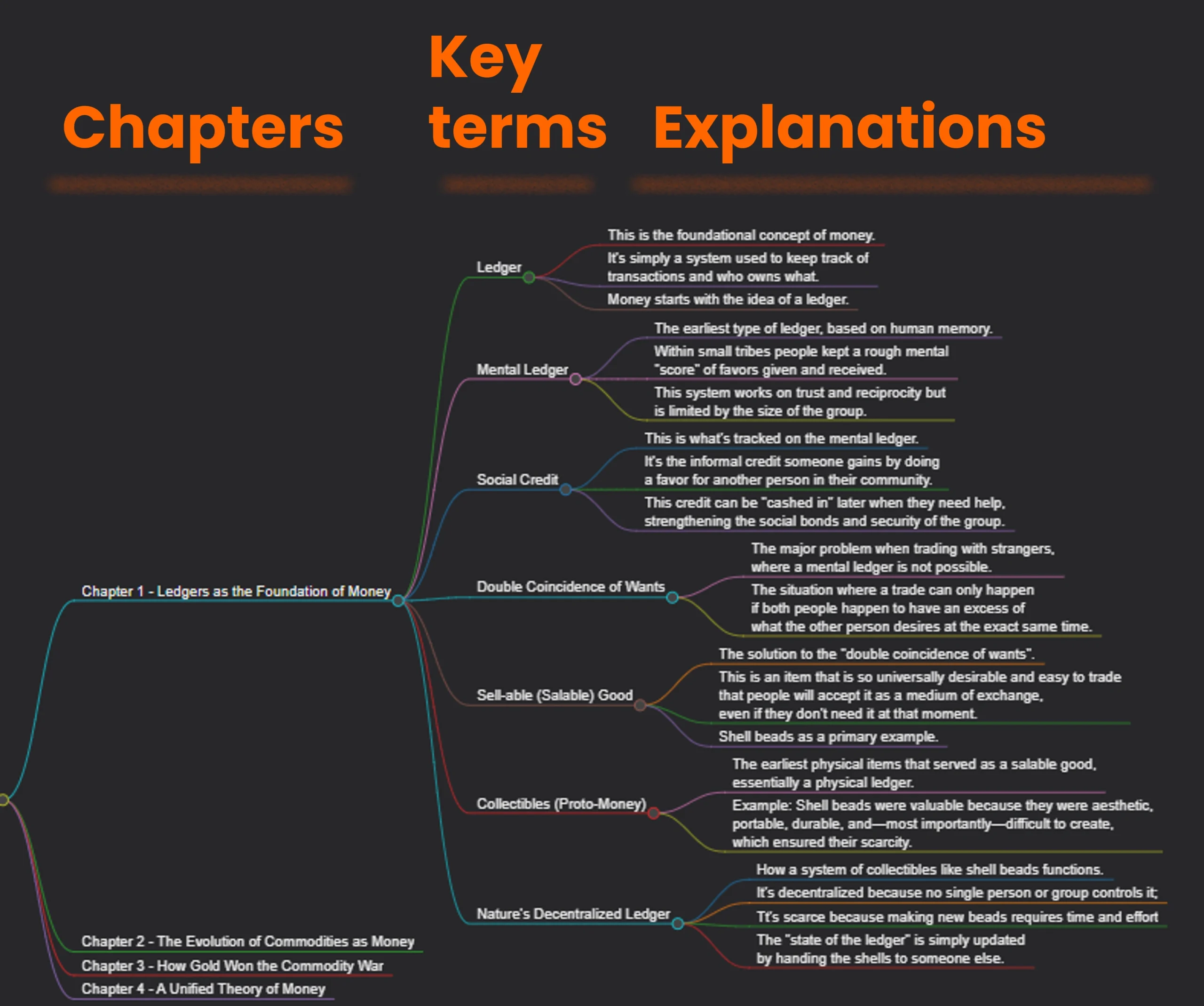A few weeks ago, I committed to an experiment that's been both frustrating and enlightening. After years of expensive double-purchasing habits—listening to audiobooks and then buying the Kindle version to "really" learn from them—I decided to break this cycle with "Broken Money" by Lyn Alden. Instead of defaulting to my usual approach, I would force myself to extract genuine knowledge from audio alone.
The challenge seemed straightforward: transform passive audiobook listening into active learning. But the reality proved more complex. How do you convert insights that enter your ears into something tangible—an externalized knowledge graph that documents your understanding?
My initial approach involved frantically scribbling notes after each chapter, usually in uncomfortable locations like changing rooms or calisthenics parks. The results were predictably messy: cramped handwriting on scraps of paper, keywords scattered without organization, chapter numbers barely legible in margins. These "pitiful papers of ugly notes," as I came to call them, captured something, but they weren't building toward the comprehensive knowledge system I needed.

Week after week, the papers piled up while I fought an increasingly intense urge to abandon the experiment. Why struggle with this inefficient process when I could simply purchase the Kindle version and return to my refined workflow? I could highlight as I read, sync those highlights to DeepRead, create structured mind maps, and build idea cards that connect with insights from other books. This system works beautifully—I've used it successfully over the past few years. The temptation to return to this proven approach grew stronger each day.
But during these moments of unproductive reflection, something clicked. The problem wasn't the concept of learning from audio—it was the manual processing bottleneck. What if I could maintain the active engagement of my experiment while leveraging AI to handle the tedious, repetitive aspects of knowledge organization?
The breakthrough came when I reframed my relationship with AI entirely. Instead of asking it to do the cognitive work for me—summarizing chapters or extracting key concepts—I began treating it as a collaborative partner in knowledge construction.
This shift represents a fundamental distinction in how we approach AI-assisted learning. The conventional approach treats AI as a cognitive replacement: "Summarize this chapter for me" or "Extract the main points from this content." This creates passive consumption of pre-digested information that disappears from memory almost instantly.
The co-working approach treats AI as a sophisticated research assistant: "Here's what I remember from this chapter—help me organize it, correct my misunderstandings, and identify what I might have missed." This maintains active engagement with the material while leveraging AI's strengths in organization, fact-checking, and gap identification.
The difference might seem subtle, but the learning outcomes are dramatically different. When AI does the thinking for you, you're consuming someone else's understanding. When AI helps you think better, you're building your own understanding with enhanced tools.
This collaborative approach also makes the entire process more interesting and engaging. Instead of feeling like a passive recipient of AI-generated summaries, you enter into a dynamic conversation where you're actively constructing knowledge together. The AI challenges your recall, suggests connections you missed, and helps refine your understanding—and this process is probably more fun for the AI as well.
Here's how the process works in practice, using my ongoing experience with "Broken Money" as a concrete example.
I continue my established routine of listening to one chapter per bike ride, maintaining full attention during these 30-50 minute sessions. The difference now is that I'm not pressuring myself to capture everything in real-time. Instead, I focus on understanding the flow of arguments and mentally flagging concepts that seem central to the author's thesis.
After each ride, I still grab whatever paper is available and jot down everything I can remember. But now I know these messy notes are just the starting point, not the final product. I capture key terms, examples, numbers, or frameworks—anything that felt important during the listening session.
This is where the magic happens. I sit down with Claude and begin a structured conversation:
First, I take a photo of my handwritten notes and upload it to the AI. Since my handwriting is often illegible (especially when scribbled in uncomfortable conditions), I also read my notes aloud to ensure the AI can decipher everything.

Next, I ask the AI to transcribe and lightly restructure my notes, organizing them into a coherent list of key concepts and insights from that chapter.
Then comes the crucial feedback loop: I ask the AI to review my understanding and identify any important concepts I might have missed, any misunderstandings in my interpretation, or any key terms that would be essential to include in a comprehensive chapter summary.
Finally, I work with the AI to create explanations for each key term in language that makes sense to me, ensuring I can access these concepts months from now.
The end result of each session is a contribution to a growing markdown file that uses the book's chapter structure as its foundation. For "Broken Money," I'm building a nested document that captures my progressive understanding chapter by chapter. Each section contains the key terms, my explanations, and notable examples or analogies that will help trigger recall later.
One example that will stick with me forever came from Lyn Alden's explanation of fiat currency creation. She describes how the entire system is essentially "debt built upon debt built upon debt," and illustrates this with the concept of "turtles all the way down." This kind of memorable analogy embeds naturally during audio listening and becomes a permanent part of my understanding of monetary systems.
The final markdown file mirrors exactly what I would normally create through my Kindle-highlighting workflow: a structured mind map of the book's main concepts, organized hierarchically and expressed in my own language. The end result is indistinguishable from the comprehensive knowledge artifacts I generate in DeepRead, but achieved through audio-only consumption.

After several weeks of experimentation, I can report mixed but promising results. The constraint of delayed note-taking has actually improved my listening attention during bike rides. I find myself more actively engaged with the structure of arguments, anticipating which concepts will be important enough to remember.
The AI co-working sessions are genuinely enjoyable. There's something satisfying about the collaborative knowledge construction process—building understanding together rather than consuming pre-made summaries. The AI often identifies connections or implications I missed during initial listening, enriching my final understanding.
However, I'm still fighting the workflow bottlenecks. Those crappy notes continue piling up faster than I can process them through AI sessions. The gap between consumption and processing creates pressure that sometimes makes me want to abandon the experiment entirely and return to the familiar efficiency of my Kindle-DeepRead approach.
The bigger test will come when I try to access this knowledge months from now. Will my AI-assisted externalized knowledge graph provide the same long-term retention and application benefits as my traditional highlighting system? Only time will tell.
If this experiment succeeds—if I can convince myself that there's a workflow allowing me to absorb audiobooks according to my personal standards—the implications extend far beyond just book consumption.
The potential becomes clear when I consider my recent audiobook history. The Brothers Karamazov, Notes from the Underground, The Selfish Gene, A Brief History of Intelligence, Consciousness Explained, The Beginning of Infinity—these are all books I initially bought as audiobooks, but they were so rich with insights that I felt deeply unsatisfied with how little I was able to absorb through listening alone. That dissatisfaction drove me to purchase the Kindle versions as well, re-read each book completely, highlight extensively, and process everything through my usual DeepRead refinement workflow. This represents an enormous time investment—essentially reading each book twice.
Imagine the time savings I could have realized if I had been able to listen to these books just once and—with some quick scribbled notes and the help of my AI co-worker—still ended up with comprehensive personal knowledge graphs. The efficiency gains would be transformational, not just incremental.
But the real potential is transformational, not just efficiency-based. Successfully extracting deep knowledge from audio-only consumption would feel like gaining a superpower. Imagine being able to listen to any book and, through structured AI co-working sessions, end up with a comprehensive externalized knowledge graph containing all your main insights.
This approach could dramatically expand the number of books I can meaningfully absorb per year. Instead of the current expensive double-consumption pattern, I could achieve single-pass mastery through AI collaboration. The learning velocity increase would be substantial.
More importantly, this workflow could extend beyond books to any audio learning content—podcasts, lectures, interviews. The principle remains the same: use AI not to replace your thinking, but to enhance your ability to think clearly about what you've heard.
You don't need to commit to a multi-week experiment to test this approach. If you're currently listening to an audiobook (one that's more than pure entertainment), you can try this method immediately.
Here's your first action: At the end of your next chapter, sit down with an AI assistant and simply brain-dump whatever you still remember. Describe everything that stood out to you as best as you can. Don't worry about organization, completeness, or accuracy—just get your recollections into words.
Then ask the AI to improve, correct, and enrich your brain-dump. This is fundamentally different from lazily asking the AI to summarize the chapter for you. Forcing yourself to reconstruct whatever you remember will first show you how little you're actually able to recall on your own. But since you're talking to a machine, you can relax without feeling embarrassed about gaps in your memory.
Having the AI criticize your understanding and help you correct errors and fill gaps creates a genuine co-working dynamic. You're still actively engaging with the book's content, just with enhanced feedback and organization support. This active engagement—this forcing yourself to recreate whatever you remember—is key for real learning.
The crucial element is having a clear end goal in mind when you enter the conversation with AI. You should aim for a specific output—a file that you and the AI work on together. The end result isn't just a conversation; it's a document that crystallizes the entire collaborative session. This file becomes what you walk away with and what you can return to for review.
Keep your target output reasonably short and structured so you can string together these files chapter by chapter. Eventually, you'll have a comprehensive summary of the book that's personal and self-created, rather than an impersonal AI summary you can't connect with.
The beauty of this approach is that you're not changing what you listen to or how you listen—you're just changing what happens afterward. Instead of hoping insights stick through passive consumption, you're actively constructing lasting knowledge with AI as your collaborative partner.
Try it once. See how it feels to work with AI as a co-worker rather than a cognitive replacement. You might discover, as I did, that this collaborative approach to learning is not only more effective but also more engaging than traditional methods.
The experiment continues, but the early results suggest we're onto something significant. Audio learning doesn't have to mean passive consumption. With the right AI co-working approach, it can become a pathway to building the same deep, structured knowledge we achieve through traditional reading—just through different means.